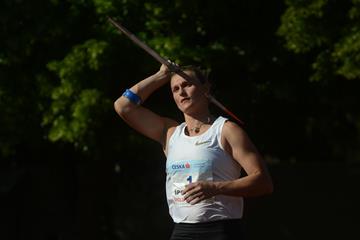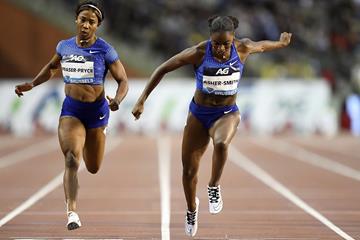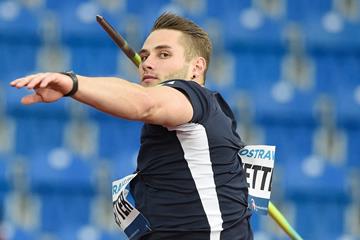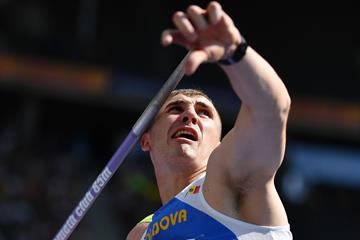 Countdown
Countdown
 Countdown
Countdown
The javelin is a track and field event where athletes compete to throw a javelin, a long spear-like object with a metal head, the farthest distance. Javelin throw is an event that takes place at the World Athletics Championships and the Olympic Games.
The javelin can be linked back to Norse mythology, with the God Odin said to have a javelin called Gungnir
Javelin was added as an event at the Ancient Olympic Games in 708 BC as part of the pentathlon
There were originally two versions of the event, one that was based on distance and another that was based on accuracy, where athletes had to hit a target
The men’s javelin was introduced to the Olympic Games in 1908 and the women’s javelin was introduced in 1932
The men’s javelin was redesigned in 1986 to prevent the high number of flat landings (when the javelin doesn’t stick into the ground). The women’s implement was similarly redesigned in 1999.
When released, javelins regularly reach speeds in excess of 60mph (96kmph)
The first -holder was Czech athlete Bozena Sramkova, who threw the javelin 25.01m and 25.32m in 1922. In 1988, German athlete Petra Felke-Meier became the first woman to throw the javelin 80 metres. She then held the world record until the specifications were changed in 1999.
The current women’s javelin world record-holder is Czech athlete Barbora Spotakova, with a distance of 72.28m. She has held the record since 2008.
The first ever was set by Swedish athlete Eric Lemming in 1912, with a mark of 62.32m. Between August 1930 and June 1936, Finnish athlete Matti Jarvinen improved the world record an incredible 10 times, with his longest throw being 77.23m.
In 1984, at the Olympic Day of Athletics competition in Berlin, German athlete Uwe Hohn obliterated the world record by throwing 104.80m. However, in 1986 the javelin was redesigned to adjust the centre of gravity and move it forwards by four centimetres. This meant it would be unlikely that Hohn’s distance would ever be beaten.
The current men’s javelin world record-holder is Czech Jan Zelezny, with 98.48m. Zelezny set the record in 1996 and since then the athlete to have got closest to that mark is Germany’s Johannes Vetter, who threw 97.76m in September 2020.
To be successful, javelin throw athletes need to have a combination of strength, power, timing and coordination. The men’s javelin has to be at least 260cm (102.4in) in length and 800g (1.8lbs) in weight. The women’s javelin must be at least 220cm (86.6in) and 600g (1.3lbs). To throw the javelin championship-winning distances, athletes need incredible upper-body strength, which is why many athletes incorporate strength training into their training regimes.
Notable men’s javelin athletes include India’s Neeraj Chopra, the Olympic and world champion, plus Olympic silver medallist Jakub Vadlejch, and Julian Weber The Czech athlete Jan Zelezny, is regarded as the finest male javelin thrower in history. He won a hat-trick of Olympic titles from 1992-2000 and set the world record of 98.48m in 1996.
Notable women’s javelin throwers include Japan’s world champion Haruka Kitaguchi, Australia’s two-time world gold medallist Kelsey-Lee Barber and world silver medallist Flor Denis Ruiz Hurtado of Colombia.
Barbora Spotakova is among the leading female javelin throwers in history, she won successive Olympic titles in 2008 and 2012 and is the owner of the women’s world record with 72.28m.

Throwing a javelin requires a huge burst of speed and strength, which means an athlete’s technique must be precise. Even the slightest flaw in technique can mean a throw falls short or results in a failure. Proper technique also ensures the safety of those around the throwing area, including officials, spectators and the athlete.
Athletes will generally throw with a full approach, though beginners will start with a standing throw or three-quarter throw. However, only with a full approach will an athlete throw the javelin the farthest possible distance.
Here’s how to throw a javelin effectively across several stages:
Hold the javelin with a preferred grip and carry it overhead pointing forwards. You should hold the javelin by its corded grip with your little finger closest to the tip of the implement.
Accelerate down the runway, making sure to maintain control and transition into a crossover step pattern.
Draw back the arm, keeping it straight and towards where the javelin will be thrown. Extend your non-throwing arm to help with balance.
Position your body in anticipation of turning that forwards momentum into upwards momentum.
Plant your leading foot firmly and rotate the hips and shoulders to face forwards.
Thrust your throwing arm forwards in one fast, smooth motion and release the javelin.
Slow momentum but don’t try to stop instantly as this can cause you to lose balance. Stop before the throwing arc and stay on your feet.
On three separate occasions, there have been javelin redesigns that resulted in changes to the event specifications and world records. The men’s javelin has been redesigned twice, while the women’s has been redesigned once.
The first men’s javelin design change was made in 1986 shortly after Uwe Hohn threw the first 100m-plus distance, which meant athletes would soon risk throwing it farther than the size of the throwing area. This wasn’t the main reason for the redesign, however, which was predominantly to move the centre of gravity forward by four centimetres to help prevent too many flat landings. The second design change came in 1999 with the removal of serrated tails.
The women’s javelin was also redesigned in 1999, when the centre of gravity was shifted forward to prevent it from travelling too far.
Key javelin rules include:
The athlete must begin the run-up within the designated runway, which is at least 30 metres long
The athlete must not turn his or her back to the landing area at any stage during their approach and throw
The athlete must not touch with any part of his or her body the lines which mark the runway or the ground outside
The javelin must be thrown over the shoulder or upper part of their throwing arm
The javelin must strike the ground with the metal head before any other part of the javelin and within the throwing sector, which is approximately 29 degrees
The distance is measured from the nearest mark made in contacting the ground when it first lands by the head of the javelin to the inside edge of the throwing arc, along a line to the centre of the circle of which the arc is part.
A failure occurs if the athlete doesn’t start his or her attempt within the time allowed, touches with any part of his or her body the lines which mark the runway or the ground outside, the javelin lands outside the landing sector, the metal head doesn’t strike the ground before any other part of the javelin, until the javelin has been thrown the athlete turns completely around so that his or her back is towards the throwing arc, the athlete fails to hold the javelin by the grip, or the athlete leaves the runway before the javelin has landed
The athlete cannot wear gloves on their throwing hand
Normally, each athlete shall be allowed three trials and the eight athletes with the best valid performances shall be allowed three additional trials. In the event of a tie, the winner will be the athlete with the next-best measure. At major championships the format is typically a qualification round followed by a final.
The standard javelin weight is 800g (1.8lbs) for men and 600g (1.3lbs) for women. The javelin weight for age groups also changes as younger athletes develop:
Men:
U18 - 700g (1.5lbs)
U20 - 800g (1.8lbs)
Women:
U18 - 500g (1.1lbs)
U20 - 600g (1.3lbs)
Javelin throwers must use the right equipment to ensure their best performance and safety.
A javelin that meets the specifications. The men’s javelin must be at least 260cm (102.4in) in length and 800g (1.8lbs) in weight. The women’s javelin must be at least 220cm (86.6in) in length and 600g (1.3lbs) in weight
Javelin shoes, which have spikes for enhanced grip and additional ankle support
Lightweight and non-restrictive apparel
Wrist support if needed for protection or medical purposes
A javelin throw belt for back and spine protection
Javelin athletes are not permitted to wear a glove on their throwing hand
At an elite level, the average javelin throw distance for men is between 80 and 90 metres (262 to 295 feet), and for women it is between 60 and 70 metres (196 to 230 feet).
This is compared to the current men’s world record held by Jan Zelezny with a distance of 98.48m, and the women’s world record held by Barbora Spotakova, with a distance of 72.28m.
The average speed of a javelin throw by elite athletes is approximately 25 to 30 metres per second (m/s) for men and 20 to 25 m/s for women. This is approximately between 45 and 68mph (72kmph and 109kmph)
 GER
GER
 TTO
TTO
 IND
IND
 GRN
GRN
 USA
USA
 KEN
KEN
 IND
IND
 BRA
BRA
 SRI
SRI
 POL
POL
 GRE
GRE
 SRB
SRB
 RSA
RSA
 AUS
AUS
 JPN
JPN
 LAT
LAT
 ECU
ECU
 COL
COL
 AUT
AUT
 NZL
NZL







